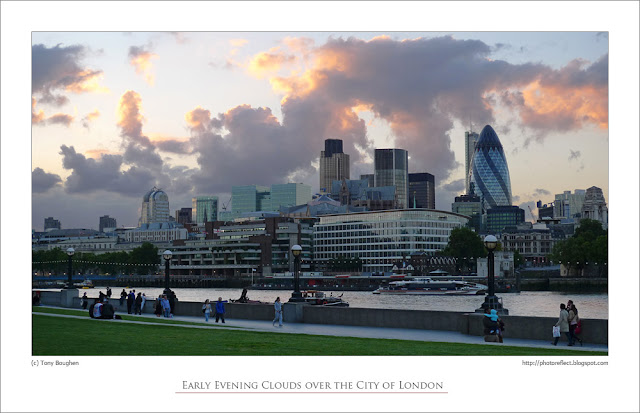click photo to enlarge
So, there I was with a family member, walking through More London in the early evening light, snapping away with my LX3 at subjects such as City Hall and "The Shard" (already the UK's tallest office block and still growing), on my way to the Marks and Spencer store located there. Our quest was for something for the evening meal, but I'd taken the small camera along for some shots as I always do on such occasions. I took a few more images of the buildings, the entrance to the food store, and, after completing our purchases, we left. As I walked through the street shown in today's photograph I stopped, raised my camera to take a photograph of the lights, the reflected sky and the patterns on the upper part of the exterior of one of the glass buildings, when it happened: someone approached me from behind and said, " You can't take photographs of this building."
The speaker was clearly someone employed on the foyer desk of the building, and who had been out somewhere (probably to Marks and Spencer) and was returning to his place of work. I won't bore you with the ensuing conversation which was polite but querying and exasperated on my part, and of the "I'm only following instructions" sort on his. Suffice to say that we went our separate ways, me to dinner and a discussion about what had happened and who I needed to write to about it, him to his desk and keeping his employers safe from the depredations of ageing amateur photographers and sundry tourists with cameras.
My first missive has gone to the owners of the private land on which the offices stand. More London is one of those hybrid spaces that are increasingly common in our cities - places where not only the buildings but the streets and the circulation spaces are private. Notices that are discreet almost to the point of invisibility tell the public this at More London. A few more prominent signs ban cycling, roller blades, skateboards and the like. No sign anywhere, to my knowledge, suggests that there is a ban on photography, and the thousands of tourists who visit the area each day merrily snap away at Tower Bridge, City Hall, HMS Belfast, the fountains, the buildings and anything else that takes their fancy. I have done so many times in the presence of the blue jacketed and overalled More London staff, with never a word spoken, and I assume they have no problem with people taking pictures. So my basic query of the landowners is whether they have a policy on photography, or do they leave such matters to the occupants of the buildings, and do they give any guidance on the matter to them. Depending on their reply (assuming I get one) I'll write to the occupiers of the building whose staff stopped me, asking what they hope to achieve through such action, suggesting why it is both counterproductive and futile, and asking them to change their policy. My third letter will be to the Mayor of London asking him to take whatever steps he can to stop the harrassment of photographers in outdoor areas of London where the public have free access, reminding him that successive Home Secretaries and the Association of Chief Police Officers have issued such instructions to police officers, and that private security staff should follow the same guidance in privately owned outdoor areas that are freely accessible to the public.
Will I achieve anything? Maybe. Maybe not. But, as ever, if you do nothing, nothing changes: if you do something, something might change. And the fact is, something needs to change.
A Google search reveals that I'm not the only person to have been accosted in this way. Interestingly, a Google image search on
"More London Place" returns 34,600,000 photographs! Those security guards and their employers are fighting a battle that was lost long ago.
photograph and text (c) T. Boughen
Camera: Lumix LX3
Mode: Aperture Priority
Focal Length: 7.9mm (37mm/35mm equiv.)
F No: f2.8
Shutter Speed: 1/200
ISO:125
Exposure Compensation: -0.33 EV
Image Stabilisation: On






















